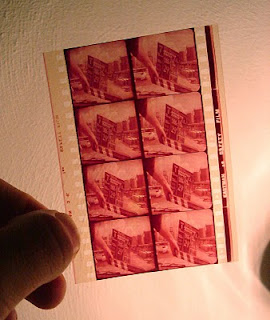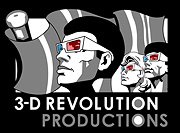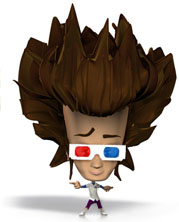3-D Film formats beyond Real-D, Dolby3D and Xpand 3-D

Digital 3-D projection is fantastic and the way forward for a prosperous future of 3-D, but despite all the huffing and puffing of the Avatar PR machine, 3-D film consumption at home is still 99.9% an anaglyph business. In recent weeks, anaglyph family member ColorCode 3D has been the main format chosen for 3-D TV broadcast in the US and the UK. While we are all familiar with the pro's and con's of the amber-blue di-chromatic system, it can still not be called much more than a clever rehash of the original stereoscopic format: anaglyph. But then, when it comes to 3-D, there has historically so far always been a constant re-invention of the wheel with few meaningful exceptions.
What can strike many as odd is that patents are granted time and again for 3-D display systems that do nothing new compared to long time existing systems. Sure, it is good for business when technologies are protected, but to lock away existing formats that have been with us for 150 years behind lawsuits and license fees may prove to be a crippling blow to an already fickle, unstable industry. What we need to do now is open up the knowledge and share the technology, or a 3-D industry will yet again not be able to establish itself properly and return to the small club of elites in the 3-D know.
Throughout the years, in 3-D feature film production, the 5 stereo encoding systems of Twin Strip, Side-by-side, Over-under, Lenticular and Anaglyph have been used and patented under many different names. 102 to be precise. Hosting the 3-D Filmography at the3drevolution.com, I have been able to compile the following 3-D feature film format names list for your reading pleasure. I personally love the crazy, wild names and I would hate to see the tradition of the invention of a 'new' zany 3-D process with every film release disappear. But, like with the non-use of negative parallax by 3-D film makers these days, the trend is getting more and more disappointingly dull: the '3-D' is mentioned as much as possible in advertising but just as that: 3-D. Or maybe 'Digital 3-D' (and, of course, Real-D and IMAX 3D), but no longer 'SpaceTerrorScopeVision 3-D'. Does it really remind people of bad 3-D experiences of the 1950's? I seriously doubt it. It is not like throwing a pick-axe at the camera in Real-D 3-D is any different as a film-going experience than seeing it hit the negative parallax barrier in StereoVision. I think the trend has more to do with the 'if it's digital, it's got to be good' attitude, regardless of the fact that two digital cameras will still need to be strapped together on a real world slide bar. And if you ask me, the act of aligning the cameras can and should still be called 'StereoCineScope-a-Rama' whenever possible, even when it doesn't sound very digital.
On to the list then. Some of the names refer to the technique in which the film was shot shot, some to the format it was printed in. Because, to give just one example, you can shoot over-under as well as printing in the format.
Glorious 3-D in Twin strip (dual source) format has been known under the name of:
3-D Video, 3Vision, Ciné Stéréo Télévision, Clear-Vision, Columbia 3-D, Depth Dimension, Dimension 3, Disney 3-D, Dual-Techniscope, Dual-VistaVision, Dynoptic 3-D, Fairall Process, Freddy Vision, Friese-Greene Stereoscopic Process, Fusion 3-D (Reality Camera System), Future Dimension, Hi-Vision 3-D, IMAX 3-D, Iwerks 3-D, Kwong-Tzan 3-D, Lipton Three-Dimensional Filmmaking System, Loucks & Norling 3-Dimension, Maurer 3-D, Metroscopix, Metrovision Tri-Dee, Miller Stereoscopic Process, Monogram 3-D, Natural Vision, Natural Vision 3-Dimension, NFBC 3-D, Norling-Leventhal 3-Dimensions, nWave 3-D, Paravision, Parkes 3-D, Parrish 3-D, Pathé 3-D, Plasticon 3-D, Plastigram 3-D, Pola-Lux 3-D, Porter-Waddell Stereoscopic Process, PSC 3-D, Ramsdell 3-D, Richardson 3-D, Sensorama, Showscan 3-D, Spacemaster 3-D, Stereo Base and Stereo-Cine.
Side by Side straight, rotated, anamorphic or in any other combination can also be called:
3D30, Bolex Stereo, Dudley 3-D, Elgeet Stereo, LazerVision, Nord 3-D, Optovision, Pola-Lite, Powell 3-D, Quadravision 4-D, Raumfilm-System, Shochiku Natural Vision, Sistema Gaultiero Gaulterotti, Stereokino, Stéréoscopic Lumière, Stereo 70, Stereovision 70 (Hi Fi Stereo 70, Triarama, Super Cinema 3-D), Tri-Delta Stereo, Western 3-D, Wolff 3-D and Wondavision (Deep Throw 3-D).
Over Under (above/below) has been recording and projecting 3-D film under the name of:
3-Depix, 3-Dynavision, ArriVision, Cinedepth, Cubic 3-D, ESI-3D, Fuji Vision, Future Dimensions, Hi Stereo Vision, Impact 3-D, McNabb 3-D, Optimax III (Dimensionscope), Plasztikus Film, Spacevision, StereoVision (Future Dimensions), StereoVision TenPerf 70, Super Touch 3-D (Real-a-Rama, Super 3D, Ultra-Cubic 3-D) and Z3D.
Checkerboard, lenticular and raster encoding is more something of a post production format, but one 3-D system manages to already shoot in it:
Cyclostéréoscope.
Anaglyph (di-chromatic), the grand daddy of them all, is also known by the name of:
3-Dimensions, 3D Plus, ColorCode 3-D, Cosmovision, DeepVision, HorrorScope (MiracleVision), Natural Vision 3, Smart Anaglyphic Fatigue Eliminator, Triangle 3-D, Trioscope and Trioviz.
And that's it. If your very own invented (or favourite) stereo format is in this list, but put in the wrong category, or does not feature in the list yet, please do contact me so that the misplacement can be rectified. The list aims to be correct and precise as possible - a challenge in these hairy days of Wild West 3-D reinvention and land grabbing!
Contact Alexander Lentjes by e-mail.
The 3-D Filmography can be found at: www.the3drevolution.com/3dlist.html




